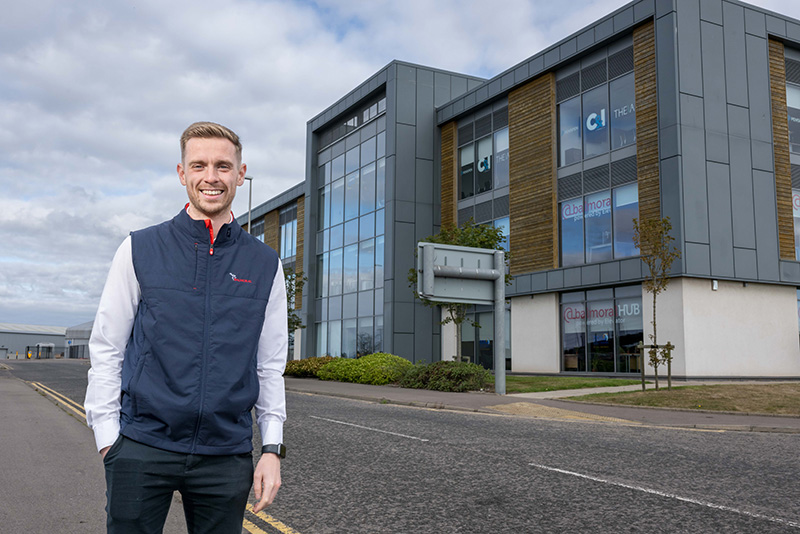
By Andrew Davidson, Balmoral Group
IT’S been a turbulent decade for Aberdeen’s economy – and for commercial property across the UK. The city, so long defined by its role in the oil and gas industry, and subsequently the broader energy sector, was hit hard by the 2014 oil and gas downturn. Investment slowed. Confidence wavered. Businesses that had expanded rapidly in the boom years found themselves consolidating, merging or exiting. Then, just as signs of recovery began to appear, the Covid-19 pandemic triggered a new kind of uncertainty – reshaping how people live, work and use space.
For commercial property, the impacts were stark. Office occupancy dropped dramatically as companies adjusted to hybrid models. In Aberdeen, these shifts were compounded by broader questions about the region’s economic direction and ability to attract and retain business in a changing energy landscape. It was a moment that tested even the most established players.
A challenging backdrop for commercial property
Aberdeen’s commercial office market has long mirrored the fortunes of the energy sector. In the years leading up to 2014, annual office take-up routinely exceeded one million square feet. Confidence was high, and the city was expanding at pace.
That changed almost overnight when the oil price collapsed from over $100 to the mid-$20s per barrel in 2014 – 2015. Take-up fell to just 190,000 sq ft in 2015, down from 300,000 sq ft the year before. Businesses halted expansion plans and restructured their property footprints. It was a dramatic correction – and one the city would feel for years.
Recovery in the years that followed was cautious. Take-up improved gradually, reaching a post-crash high in 2019 – a sign that confidence was returning. Then came Covid-19. The pandemic, coupled with renewed oil price volatility, saw office activity fall sharply, again.
Since then, demand has become more selective. Hybrid working has taken hold, reshaping expectations about what an office should offer. Flexibility, functionality and a sense of community have overtaken square footage as key drivers. Across the board, companies are seeking quality space that can adapt to their needs and support the way people want to work.
That’s the environment which has been created at Balmoral Business Park – offering the space, adaptability and long-term commitment that Aberdeen’s businesses have needed most.
Backing belief over short-term yield
Located just off the A90 as you reach the top of Wellington Road is Balmoral Business Park, which houses car showrooms and office accommodation – including Building One, Balmoral’s answer to supporting innovation and enterprise in the city.
Built and opened in 2014, Building One was a dream that launched right into the oil price downturn. Yet, a significant investment at an uncertain time, it was underpinned by Balmoral Group’s long-term belief in Aberdeen’s resilience. Unlike many developments that rely on immediate yield, Balmoral took a patient view: that the city’s expertise, infrastructure, diverse industries and spirit of enterprise would drive its next chapter, even if the path was uneven.
Over the following years, as economic confidence ebbed and flowed, the business park quietly became a base for growth and its flexibility proved key. While Audi, Volvo and Mini took residence on Balmoral’s land in the park, and Lomond House started to thrive with its own tenants, businesses that might have hesitated to commit to larger, long-term leases found an adaptable home in Building One – whether they needed a suite for two or an open-plan office for 100. Over time, tenants grew. Some scaled rapidly; others settled into long-term residency, making the space their own. Crucially, many remained, expanding internally rather than moving on – a sign that the space could evolve with them. Alongside this, Lomond House continues to offer office, warehouse and yard space in an extended flexible environment for its tenants.
Today, more than 25 businesses call Building One home, representing sectors as diverse as engineering, digital services, HR, health and wellbeing and construction. The tenant mix reflects not only Balmoral’s growing diversification as a group, but also Aberdeen’s broader efforts to rebalance its economy – shifting from fossil fuel dependency towards a more resilient, multi-sector future.
Built to last, and built for Aberdeen
That spirit of resilience is built into the foundations – not just of the business park, but of Aberdeen itself. This isn’t the first downturn the city has faced, and it won’t be the last. From the sharp recessions of the 1980s to the global financial crisis in 2008 and the dual impact of oil price crashes and pandemics, the city has always found a way forward. More than just surviving and adapting, it has found strength through its deep-rooted industries, its skilled workforce and its unwavering sense of identity.
Building One and its surrounding neighbours have quietly mirrored that resilience. Moreover, the business park was designed with community and connection in mind; with shared common spaces for tenants across Building One and Lomond House, EV charging, ample parking and a management ethos that favours listening to tenant needs over imposing rigid rules. It’s never been about filling space. It’s about creating an environment that people want to work in, and a base that supports businesses as they navigate their own challenges and ambitions.
And while the commercial model works – providing long-term income for Balmoral Group – it’s also part of a much bigger picture. The success of the business park feeds directly into Balmoral’s wider purpose: to reinvest in people and communities through charities and initiatives like Friends of ANCHOR and the Milne Family Foundation. That circularity is unusual in the property world. This is a space that supports growth, yes – but also gives back.
As the UK grapples with the future of work, and as Aberdeen repositions itself within the energy transition and wider economy, the story of Balmoral Business Park is one of quiet confidence. It has simply offered good space, strong support and long-term commitment – staying the course when others might have stepped back.
For the businesses inside, it’s more than just an address. It’s a place to start, to scale and to stay. And for the city, it’s a reminder that the future isn’t built overnight – but through patient investment, local belief and spaces that make growth possible.











